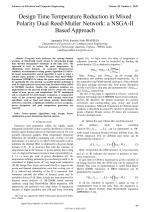| 1/2020 - 13 | View TOC | « Previous Article | Next Article » |
Design Time Temperature Reduction in Mixed Polarity Dual Reed-Muller Network: a NSGA-II Based ApproachDAS, A. |
| Extra paper information in |
| Click to see author's profile in |
| Download PDF |
Author keywords
genetic algorithms, logic design, Pareto optimization, power dissipation, thermal analysis
References keywords
thermal(7), power(6), aware(6), pradhan(5), circuits(5), systems(4), reed(4), optimization(4), muller(4), design(4)
Blue keywords are present in both the references section and the paper title.
About this article
Date of Publication: 2020-02-28
Volume 20, Issue 1, Year 2020, On page(s): 99 - 104
ISSN: 1582-7445, e-ISSN: 1844-7600
Digital Object Identifier: 10.4316/AECE.2020.01013
Web of Science Accession Number: 000518392600013
SCOPUS ID: 85083705344
Abstract
Proposed work addresses the existing thermal problem of OR-XNOR based circuit by introducing design time thermal management technique at the logic level. The approach is used to reduce the peak temperature by eliminating local hotspots. In proposed thermal-aware synthesis, non-dominated sorting genetic algorithm-II (NSGA-II) based meta-heuristic search algorithm is used to select a suitable input polarity of Mixed Polarity Dual Reed-Muller Expansion (MPDRM) to reduce the power and power-density by optimizing the area sharing. A parallel tabular technique is used for input polarity conversion from Product-of-Sum (POS) to MPDRM function. Finally, the optimized solutions are implemented in the physical design level to obtain the actual values of area, power, and temperature. MCNC benchmark suit is considered for performance evaluation. A comparative study of the proposed approach with existing state-of-art algorithms such as fixed and mixed polarity Reed-Muller network is reported. A significant reduction in area occupancy, power dissipation, and peak temperature generation are reported. |
| References | | | Cited By |
Web of Science® Times Cited: 6 [View]
View record in Web of Science® [View]
View Related Records® [View]
Updated today
SCOPUS® Times Cited: 6
View record in SCOPUS® [Free preview]
View citations in SCOPUS® [Free preview]
[1] Yapay zeka tarafından kontrol edilen yeni bir termoelektrik CPU soğutma sistemi, UMUT, İlhan, AKAL, Dinçer, Gazi Üniversitesi Mühendislik Mimarlık Fakültesi Dergisi, ISSN 1300-1884, Issue 1, Volume 39, 2023.
Digital Object Identifier: 10.17341/gazimmfd.1150632 [CrossRef]
[2] Delay optimization for ternary fixed polarity Reed–Muller circuits based on multilevel adaptive quantum genetic algorithm, Zhenxue, He, Xiaoqian, Wu, Chao, Wang, Zhisheng, Huo, Limin, Xiao, Xiang, Wang, International Journal of Intelligent Systems, ISSN 0884-8173, Issue 10, Volume 36, 2021.
Digital Object Identifier: 10.1002/int.22538 [CrossRef]
[3] An Efficient and Fast Area Optimization Approach for Mixed Polarity Reed-Muller Logic Circuits, Zhou, Yuhao, He, Zhenxue, Jiang, Jianhui, Zhao, Xiaojun, Zhang, Fan, Xiao, Limin, Wang, Xiang, Chinese Journal of Electronics, ISSN 2075-5597, Issue 5, Volume 33, 2024.
Digital Object Identifier: 10.23919/cje.2022.00.407 [CrossRef]
[4] Ship route and speed multi-objective optimization considering weather conditions and emission control area regulations, Ma, Weihao, Lu, Tianfu, Ma, Dongfang, Wang, Dianhai, Qu, Fengzhong, Maritime Policy & Management, ISSN 0308-8839, Issue 8, Volume 48, 2021.
Digital Object Identifier: 10.1080/03088839.2020.1825853 [CrossRef]
[5] Area and power optimization for Fixed Polarity Reed–Muller logic circuits based on Multi-strategy Multi-objective Artificial Bee Colony algorithm, Qin, Dongge, He, Zhenxue, Zhao, Xiaojun, Liu, Jia, Zhang, Fan, Xiao, Limin, Engineering Applications of Artificial Intelligence, ISSN 0952-1976, Issue , 2023.
Digital Object Identifier: 10.1016/j.engappai.2023.105906 [CrossRef]
[6] Minimization for ternary fixed polarity Reed–Muller expressions based on ternary quantum shuffled frog leaping algorithm, He, Zhenxue, Xiao, Limin, Wang, Xiang, Applied Soft Computing, ISSN 1568-4946, Issue , 2021.
Digital Object Identifier: 10.1016/j.asoc.2021.107647 [CrossRef]
Disclaimer: All information displayed above was retrieved by using remote connections to respective databases. For the best user experience, we update all data by using background processes, and use caches in order to reduce the load on the servers we retrieve the information from. As we have no control on the availability of the database servers and sometimes the Internet connectivity may be affected, we do not guarantee the information is correct or complete. For the most accurate data, please always consult the database sites directly. Some external links require authentication or an institutional subscription.
Web of Science® is a registered trademark of Clarivate Analytics, Scopus® is a registered trademark of Elsevier B.V., other product names, company names, brand names, trademarks and logos are the property of their respective owners.
Faculty of Electrical Engineering and Computer Science
Stefan cel Mare University of Suceava, Romania
All rights reserved: Advances in Electrical and Computer Engineering is a registered trademark of the Stefan cel Mare University of Suceava. No part of this publication may be reproduced, stored in a retrieval system, photocopied, recorded or archived, without the written permission from the Editor. When authors submit their papers for publication, they agree that the copyright for their article be transferred to the Faculty of Electrical Engineering and Computer Science, Stefan cel Mare University of Suceava, Romania, if and only if the articles are accepted for publication. The copyright covers the exclusive rights to reproduce and distribute the article, including reprints and translations.
Permission for other use: The copyright owner's consent does not extend to copying for general distribution, for promotion, for creating new works, or for resale. Specific written permission must be obtained from the Editor for such copying. Direct linking to files hosted on this website is strictly prohibited.
Disclaimer: Whilst every effort is made by the publishers and editorial board to see that no inaccurate or misleading data, opinions or statements appear in this journal, they wish to make it clear that all information and opinions formulated in the articles, as well as linguistic accuracy, are the sole responsibility of the author.



